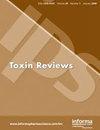Ocular sequelae of snakebite envenoming: a review of the indirect effects of snakebite envenoming on the eye
IF 2.4
4区 医学
Q2 TOXICOLOGY
引用次数: 0
Abstract
AbstractSnakebite envenoming is a major public health issue in developing, often agricultural-based, tropical countries, which causes substantial mortality and morbidity. Most studies have been conducted on well-known toxic effects such as neurotoxicity, cytotoxicity, and hemotoxicity, however, there is scarce information on their indirect effects on the eye. In this review, we provide an overview of ocular pathologies caused by snakebite envenoming. In total, 65 cases, described in 42 case reports and series, were identified in the PubMed and Embase databases. Most reported ocular toxicities/disorders after snakebite envenoming were ophthalmoplegia (12 cases), intra- and peri-ocular hemorrhages (9 cases), and acute glaucoma (13 cases). We also discuss the possible mechanisms for these ocular pathologies. Interestingly, optic neuropathy might be an adverse effect of antivenom instead of directly being caused by envenoming. We prompt recognition of this largely overlooked topic within the field of snakebite, and further stress the need to combat this neglected tropical disease.Keywords: Ophthalmologysnakebiteenvenoming AcknowledgementsWe would like to thank Dr. Wolfgang Wüster for letting us use photographs from his personal database and Prof. Dr. Ymkje Stienstra for her useful comments on our manuscript.Disclosure statementNo potential conflict of interest was reported by the author(s).Additional informationFundingThe author(s) reported there is no funding associated with the work featured in this article.蛇咬伤的眼部后遗症:蛇咬伤对眼睛间接影响的综述
摘要蛇咬伤是发展中国家的主要公共卫生问题,通常以农业为基础,热带国家,它造成大量的死亡率和发病率。大多数研究都是关于众所周知的毒性作用,如神经毒性、细胞毒性和血液毒性,然而,关于它们对眼睛的间接作用的信息很少。在这篇综述中,我们提供概述了由蛇咬伤引起的眼部病变。在PubMed和Embase数据库中,总共确定了42份病例报告和系列中描述的65例病例。蛇咬伤后的眼部毒性/疾病报告最多的是眼麻痹(12例)、眼内和眼周出血(9例)和急性青光眼(13例)。我们还讨论了这些眼部病变的可能机制。有趣的是,视神经病变可能是抗蛇毒血清的副作用,而不是由蛇毒血清直接引起的。我们敦促在蛇咬伤领域认识到这一在很大程度上被忽视的问题,并进一步强调防治这一被忽视的热带病的必要性。我们要感谢Wolfgang w博士允许我们使用他个人数据库中的照片,并感谢Ymkje Stienstra教授对我们手稿的有用评论。披露声明作者未报告潜在的利益冲突。其他信息资金作者报告没有与本文所述工作相关的资金。
本文章由计算机程序翻译,如有差异,请以英文原文为准。
求助全文
约1分钟内获得全文
求助全文
来源期刊

Toxin Reviews
医学-毒理学
CiteScore
6.80
自引率
0.00%
发文量
36
审稿时长
>12 weeks
期刊介绍:
Toxin Reviews provides an international forum for publishing state-of-the-art reviews and guest-edited single topic special issues covering the multidisciplinary research in the area of toxins derived from animals, plants and microorganisms. Our aim is to publish reviews that are of broad interest and importance to the toxinology as well as other life science communities. Toxin Reviews aims to encourage scientists to highlight the contribution of toxins as research tools in deciphering molecular and cellular mechanisms, and as prototypes of therapeutic agents. Reviews should emphasize the role of toxins in enhancing our fundamental understanding of life sciences, protein chemistry, structural biology, pharmacology, clinical toxinology and evolution. Prominence will be given to reviews that propose new ideas or approaches and further the knowledge of toxinology.
 求助内容:
求助内容: 应助结果提醒方式:
应助结果提醒方式:


